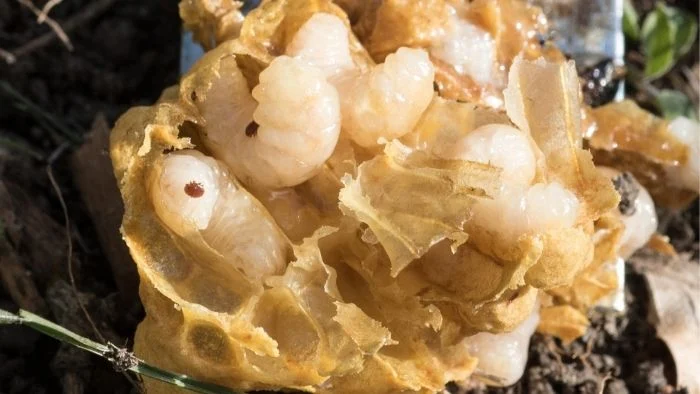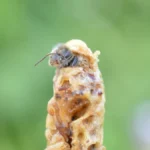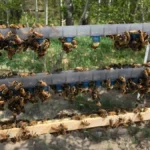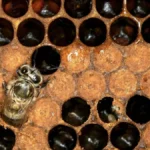What is bee brood? This is the next generation of bees – it is the part of the hive that produces bees constantly to replenish and grow the hive population. To fully answer the question “what is bee brood?” we will have to take a far deeper dive into what the brood nest is, how it works, and what it contains.
The structure of a beehive consists of honeycombs spaced according to the rule of “bee space” in a hive. The combs can be used for rearing bees (brood), processing and storing pollen (bee bread and pollen stores), and processing nectar into honey (honey stores). In this article, we will take an in-depth look at the bee brood combs. These combs typically are close to the entrance of the hive and are surrounded on each side by pollen and honeycombs.
What Is Bee Brood?
Bee brood is the collective term we use for all the developmental stages of a bee in the comb from egg to young emerging bee.

Learn more about: What Does Capped Brood Look Like?
The Brood cycle
The queen bee is guided to the area where eggs are needed by her retinue of workers. She is constantly fed royal jelly while she is working laying eggs. This provides her with a highly nourishing nutrient source and allows her to lay up to 4000 eggs a day (Apis mellifera scutellata). The queens of most other races of bees can manage up to 2000 eggs per day.
When she places her abdomen in a cell there are three types of cells she can do so in. The smallest cell is a worker cell – she will lay a fertilized egg in the bottom of such a cell and it will develop into a worker (female). A queen cup is a larger cell, and into this, she will also lay fertilized eggs – this will develop into a queen (female). If she has to place her abdomen in a drone cell, this is much wider than a worker cell or queen cup, and a small nerve in her legs sends a message that her legs are wide apart and sperm cells are consequently not allowed out of the spermatheca where she stores the sperm from her mating flights – this means when she lays an egg it will be an unfertilized egg. An unfertilized egg develops into a drone.
When all egg types hatch after three or so days, they are fed royal jelly – the small larvae actually float at the bottom of the cell in this film of nutrition and grow rapidly. A queen larva is fed royal jelly for her entire developmental stage and this causes her to grow exceptionally fast. Workers and drones are only fed royal jelly for the first few days of their development, after which they are fed pollen.
What Happens To The Queen Brood?
The maximum number of queen cells we would expect to see in a hive would maybe be 50-80 cells in a strong hive. Many hives will only rear 10 or so. The first queen to hatch will jump out of her cell and go and hunt down other queen cells and sting the queens inside to death. If a queen meets another queen they will often fight to the death.
Queen brood is a very small component of the hive and is only present during the swarming season, or when a queen dies and has to be replaced. We can also trigger queen cell development when engaging in queen rearing.
Queen brood cells are nutrient-dense, and basically, the queen is a ball of eggs with a bee wrapped around it. So the main nutrients in the queen bee are focused on the role she will play as a layer of eggs and producer of pheromones.
What Happens To Drone Brood In The Brood Nest?
Bees produce drones to spread the genes of the hive to other hives. Drones are big!! Natural worker cells are 4.5 mm (Apis mellifera capensis) to a maximum of about 5.1 mm for larger races. Drone cells on the other hand are 6,4-6,6mm in diameter. The actual cells in which drones develop are also considerably deeper than worker cells. Drones are big, relatively dumb boys whose sole objective and real function in life is to go out, find a queen, and mate with her. They die afterward.
Bees can at times produce huge amounts of drone brood – I have removed wild hives that had ten or more pounds of drone brood. In many managed hives, people try to reduce drone production – this is rather bad for the bees as it reduces natural gene flow and the ability of healthy hives to transfer genes into genetically unhealthy hive populations. This is one of the reasons the European honeybee is such a genetically pathetic bee prone to diseases and collapse.
A drone is basically a very big testicle full of bee semen, that has some wings and a navigation system, and a stomach to nourish it. Drones are not intellectually gifted whereas workers are quite clever little creatures. Drone brood is basically a whole lot of drone comb, filled with muscles and semen.
This is why it is consumed as an aphrodisiac in many countries. Often, human male sexual function issues can be caused by nutrient shortages – drones are a good source of the sort of nutrients that the male human reproductive system needs – and hence eating drone brood, lightly sauteed in butter with garlic, for instance, would be a wise thing for any guy to do if he was planning to be a bit of a bedroom champion occasionally.
Removing drone brood from the hive occasionally is also an excellent way of controlling varroa mites. If you find eating drone brood a bit off-putting, feed it to your chickens – the magical lipids in the drone brood will come back in your chicken eggs.

What Happens To Worker Brood In The Brood Nest?
The vast majority of brood in a hive is normally worker brood. A queen can lay at least 2000 eggs a day. If we assume a worker takes 18 days to hatch, that means that if a queen is laying at this rate, the hive population receives about 2000 new workers a day. If we assume the bees are healthy and working hard, then the workers live about 40 days, which means the hive increases in number quite rapidly. For African bees, a queen laying 4000 eggs a day naturally leads to mind-bogglingly huge beehives (or a lot of swarms).
If we look at the worker bee, it develops and emerges and moves through a range of different tasks in the hive. One such task is making wax. Bees are consequently an exceptionally rich source of nutrients. You will notice this if you happen to have a bit of spare bee brood to fry. The best is to take a light white comb that has brood in it. Fry this with garlic and green peppers and you end up with something that looks like very small shrimp. Absolutely delicious and you will feel healthy the next day. There is a reason a honeybadger is so clever – they eat a lot of bee brood!
Read more about Drone Brood vs Worker Brood
What is bee brood? A treasure chest of nutrients, and the most vital component of the beehive! As we become more aware of the benefits of including insects in our diets (as our ancestors did for a long time) we will soon probably see more people enjoying a bit of fried bee brood every now and then! Once you know…you know. If you enjoyed this article please share.
FAQs
[rank_math_rich_snippet id=”s-adc837bf-e07a-4e66-b7d1-b760214d23a2″]

Dr. Garth A. Cambray is a Canadian/South African entrepreneur and beekeeper with 28 years of experience in apiculture and specializes in adding value to honey. His Ph.D. research developed a new advanced continuous fermentation method for making mead that has resulted in a number of companies globally being able to access markets for mead. His company, Makana Meadery, exports honey mead to the USA where it is available to discerning connoisseurs. He has also developed technologies to commercially manufacture organic honey vinegar in Zambia for export globally. He holds a few patents globally in the ethanol industry and believes in technology and knowledge transfer for human development and environmental sustainability. One of his proudest achievements is the fact that the wind farm he started at one of his old apiary sites has essentially made his hometown carbon neutral.






